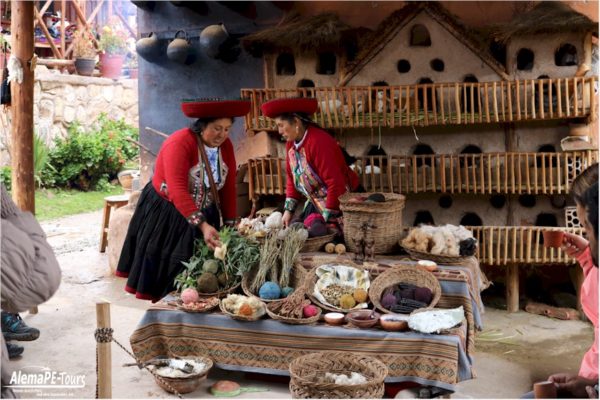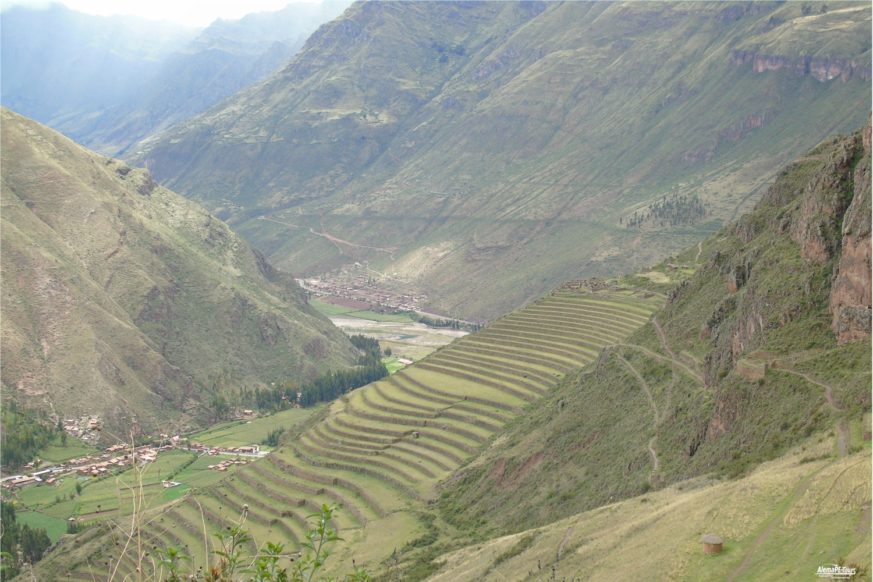THE SACRED VALLEY
Cusco • Pisaq • Ollantaytambo • Chinchero • Cusco
1 D
About the Sacred Valley
The Sacred Valley of the Incas is located between the picturesque colonial Cusco, the former capital of the inca empire, and the mystical citadel of Machu Picchu. It was worshiped by the incas for its fertile soils. The incas populated the valley and farmed up to highly scientific agricultural science. Even today you can find traces of the inca everywhere in the valley. The valley on the Urubamba river is also a paradise for adrenaline-seeking adventure tourists and people who want to free themselves for a few days in the idyllic, small andin place from the hectic civilization.
The most famous ruins, which are among the most visited attractions today, are the former fortresses of Pisac and Ollantaytambo. From Cusco, Pisac is the first stop on the tour of the Urubamba Valley for many travelers. The small village is best known for its market, where you can buy souvenirs at reasonable prices. The arts and crafts market is the country’s largest open-air market. High above the city and several steps away stands a fortress in the typical incan style. Tons of heavy boulders that were stacked on each other without any binding. Another highlight of Pisac are the impressive terraces created by the incas on the slopes of the mountains.
Another popular place in the Valle Sagrado is Ollantaytambo. Here you will find another preserved inca fortress, which was probably built around 1460 by the inca Pachacutec. It is one of the few places where the spaniards suffered a defeat. In 1537, the conquistadors were subject to inca chief Manco inca here in the battle of Ollantaytambo. In the local biomuseum you get an insight into the biodeversity on the example of the potato, of which there are about 5,000 different varieties in Peru. Another interesting museum is the CATCCO, a small ethnographic museum that explores the history and culture of the people of the Urubamba Valley.
However, the Urubamba Valley has more to offer than culture and architecture. Adventurers among you can spend time rafting in the raging Urubamba River or trekking in various trekking tours on the safe shoreline to explore nature. In any case, the Sacred Valley of the Incas is worth a visit when you travel to Peru. Take a look at our other offers…
Pisac
Pisac, or Quechua Pisaq, is located near the andean city of Cusco, at the southern entrance of the Valle Sagrado, the sacred Urubamba valley, which is dotted with sublime Inca citadels, charming andean villages and by far the most beautiful craft markets in the region. The best way to plan the tour to Pisac for a sunday, because there you can admire the lively hustle and bustle best in the market. Right next to the market in Pisac, you will find a beautiful textile and craft market, which is also open daily. After a long stroll through the market stalls, you will also have some nice souvenirs, silver jewelry, musical instruments, blankets and alpaca wool clothing at a much lower price than in Cusco.

Pisac is an ideal starting point for several hours of trekking tours to the ancient Inca ruins. You can also reach them by bus from Cusco. Do you want to make an ascent on foot, so you will meet a steep, about 4.5 km long hiking trail. Along the way, you will encounter small tunnels, massive stone gates and also the first terraces that run in large arches around the southern mountain flank.
Once at the top, you can see the old mountain fortress over the long expiring terraced gardens. Here is also the center of the Inca culture at its peak in the history of Peru.
Impressive at this point are the many innumerable terraces, which reach far below the slope of the mountain under and beside the urbanistic plants. At the middle of the temple area, massive, very distinctive rocks of volcanic origin, called Intihuatana (after the sun god Inti), the sun is bound to the faith of the ancient Inca. Right next to the old mountain fortress is an old Inca cemetery. If you have time left after the ascent and tour of the fortress, you can stay here and enjoy the views of both the Urubamba Valley and the slopes of the Inca cemetery.
Ollantaytambo – The mysterious inca fortress
The ruins of Ollantaytambo, situated above the Urubamba river, are located in the Sacred Valley of the incas. Here once again the typical urban planning of the inca can be. The grounds are still in a very good condition and you can understand the effort of the construction, if you make the effort of the ascent on the countless steps. But who has managed to do so, can enjoy the fascinating view over Ollantaytambo and the Urubamba valley.
Opposite the fortress there are also some buildings on the mountainside. These are the old storehouses of the inca, which because of the cooler climatic conditions caused by shadows and wind there are very good ways of storing food, such as potatoes offered. Usually only tourists who do not reach Ollantaytambo on the guided bus tours get there. A steep unpaved path also allows you to reach this point. It is also necessary to allow more time for this because, due to the altitude, you have to take enough breaks so that the oxygen requirement does not suffer.

In Ollantaytambo there is usually a milder climate than in Cusco. From Cusco you can take the guided bus tours or public transport to Ollantaytambo. If you want to take the public buses, in Cusco go to the intersection Av. Gray / Puente Gray. There is the “Terminal de buses” where the big buses and small collectivos / station wagon / shared taxis depart. Some of the collectivos drive directly to Ollantaytambo, others stop in Urubamba, where you then have to change again. A taxi ride is also affordable with one of the taxis organized by hostels or hotels.
The small village is not only fascinating because of its imposing fortress. Also, the village architecture of the Incas, which dates back to the 15th century area, has charming lanes with original antiquarian charm. The walled Canchas (these are the walled farmhouses) of the inhabitants are still impressive today, especially since the population within the village still largely lives as in ancient times.
Several habits, which are found only rarely in the big cities, are still lived here. So it is still here, his dead relatives in his own house to store and in no velatorio (a kind of morgue) to bring. The connectedness within families is still of great importance here. As an outsider you can be surprised when someone is approached and led you into the house. Small dishes such as galletas de soda (a kind of salty crackers) and Coffee or Chicha are then welcome. It is usually drunk at many body shows in Peru more than in some restaurant.
In addition to visiting the fortress and temple complex Ollantaytambo is also an interesting point to continue by train to Macchu Picchu. As the train tickets are cheaper from here onwards, there are always tourists who stay in town for one or two days. If you plan your tour planning as a whole, you should consider this option as needed. In Ollantaytambo there are enough hostels, hotels and restaurants, cafes and a variety of small shops selling beautiful crafts.
Chinchero – Peruvian wool processing
The ancient andean capital Chincheno lies on the highlands of the andes surrounded by lagoons and wide fields. Chinchero is known for its very traditional market where barter is often used. Every sunday, traders come from Chinchero and from further afield and open their stands at a very early hour. They distribute their goods on tarpaulins and thus forms the sunday market with many offers from the colorful arts and crafts. Of course, vegetables and a variety of potato varieties are also available for the fine national dishes.
The market has been held for several generations and since time immemorial finds its place in front of the snow-white village church. Completed at the beginning of the 17th century, the church, whose foundations date back to the inca times, served as the foundation for the palace of the 10th Inca Tupac Yupanquis. The walls inside and the roof of the church are dotted with many religious drawings depicting great personalities from history such as the caciques Pumacahua, the Inca Túpac Amaru, gods and many other inca mythological figures.
We definitely recommend visiting one of the many wool processing shops here in Chinchero. There you will learn about the production of wool, its cleaning and coloring with natural colors. At the same time there is the possibility to buy some wool products at lower prices.

Program
Your journey through the Sacred Valley will begin around 8:30 am, when you will be picked up from your hotel. With our private transport, we will head for the Sacred Valley of the Incas. In Pisaq you will be able to enjoy the wonders of the valley, for the place of its´ archeological centre lies on the mountain in harmony with nature. The village of Pisaq has an enormous cultural attractiveness, because of its colonial streets and impressive hills around it, which form a charming landscape. Part of its´ attractiveness is also the handcraft market.
After continuing our trip, we will be brought to magnificent scenery of mountains and snow-covered mountaintops. We arrive in the village Ollantaytambo and will visit the archeological complex, which type of constructing is as old as its´ great stones. The complex presents a collection of houses, temples, platforms, colcas (deposits) and several enclosures of which the function is not determined yet.
The village of Ollantaytambo is seen as the last Andean village because of the houses and narrow streets that shows us the Inca style of constructing.
Before returning to Cusco, we will visit our last tourism attraction, Chinchero, during a spectacular sunset. The village of Chinchero offers us an enormous tourist potential, because of its´ spectacular colonial church, archeological sights and market. After this, we will return to Cusco at about 6.30 pm.
Price
Please contact us to get the price of this tour.
Tour-ID
CUZ025
Duration
1 D
Included
- Private tourist transport.
- Professional guide in English or Spanish.
- Entrance to the archeological complexes (General boleto tourístico).
- Lunch in the sacred valley of the Incas “Restaurante Tunupa or Sol y Luna”.
Not included
- Boleto Turístico for visiting the archeological places.
- Meal during the excursion (There are restaurants in the village of Calca, where the group can enjoy whatever lunch they like)
Further information
Notes:
- A valid Boleto Turistico (Tourist Ticket) is necessary for this trip.
These tickets can be purchased from our agency or the City of Cusco’s Tourist Office.
Each ticket is valid for ten days from the date of purchase.





